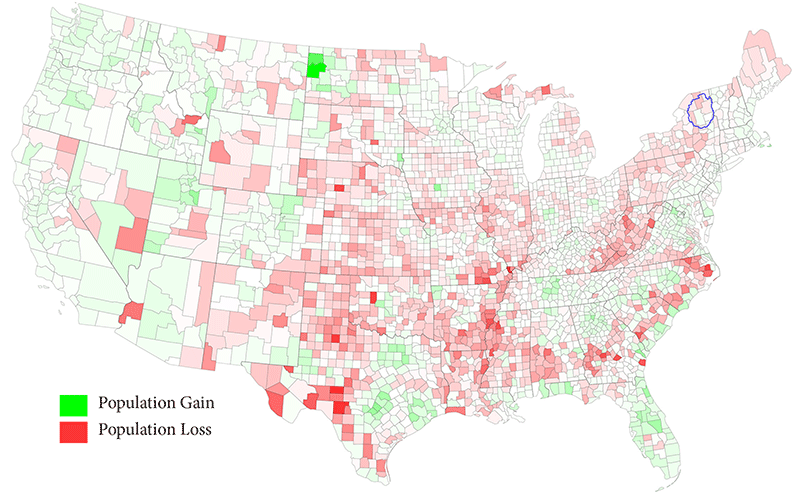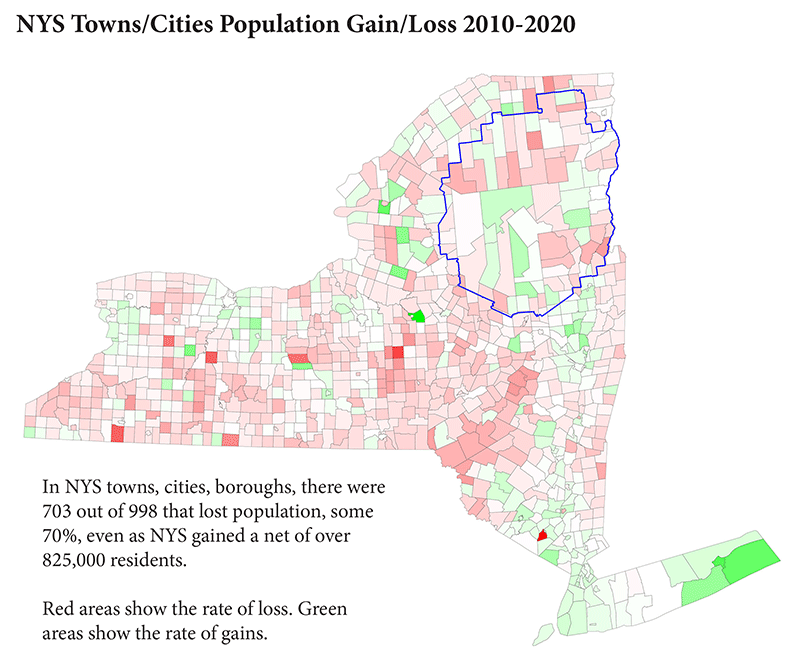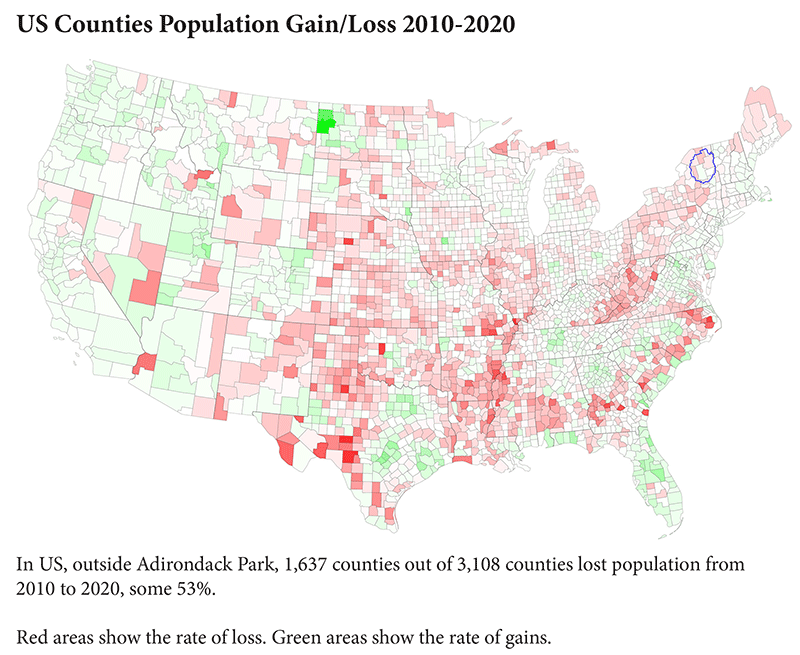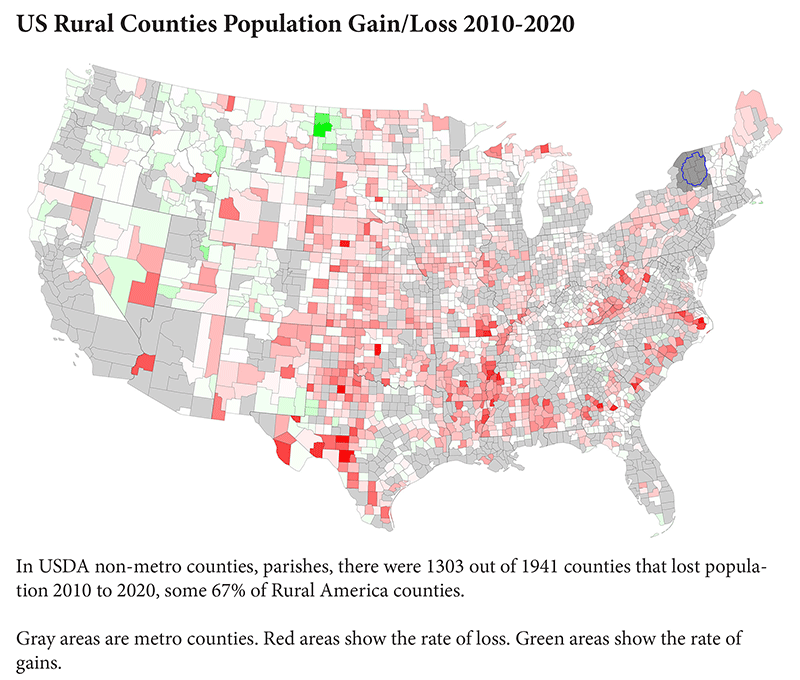In the Adirondacks, I thought we had moved beyond weak economic and social analysis that blames the Park for all of the problems and challenges facing Adirondack communities. I thought that many in the Adirondacks had looked at long-term national rural population and economic trends and learned that the issues facing Adirondack communities are the same issues facing Rural America – and that the first decades of the 21st Century in the U.S. have proved extremely difficult and challenging times for Rural America.
But I was wrong. A recent editorial in Sun Community News went in big with a blame-the-Park rant. Its editorial started out lamenting the closure of an Emergency Room at Adirondack Health in Lake Placid but then went all in on blaming the Park. Now, I live in a community in Hamilton County where we’re at least an hour’s ambulance drive from the nearest Emergency Room, so I get the concerns about the ER closure.
According to the editorial, the ER closure was brought about by “Too many expenses, not enough users and a shortage of staff.” These factors, they said “sound familiar because they could apply just as easily to a restaurant, a school or a souvenir shop as a medical emergency room.”
Fair enough, but then the editorial pivots to make big fact-less and data-free leaps: “And that brings us to the heart of the matter: By design, the state, in the form of the Adirondack Park, limits population density, it limits growth and it limits wealth. We grouse about this, but most of us understand the end goal, even if we don’t always agree with it.”
From here on out, the editorial was full-on blame-the-Park. The editorial provides no facts or figures or context. Nothing. In 2019, Protect the Adirondacks released a report The Adirondack Park and Rural America: Economic and Population Trends, 1970-2010, which looked at long-term economic and population trends to see if something fundamentally different was going on in the Adirondacks than in other rural areas. The answer we found was no. We found that everything going in Adirondack Park communities was the same as issues facing thousands of rural communities and counties across the U.S., from Maine to Oregon, from Montana to Alabama. The 2020s are proving to be tough times in Rural America.
Without going into exhaustive detail and regurgitating the report, let’s look at recent trends from 2010-2020 that we’ve been looking at as we start the work of updating our report to include 2020. Unfortunately, given the slow pace for the release of 2020 Census data, we don’t have final results for the local Adirondack population, but it seems the Park’s population for the 61 towns that are 100% within the Blue Line experienced a 2-4% population loss from 2010, something like a drop from 101,000 to 99,000. (The prison population numbers confound this analysis, for which we need more detailed Census data to analyze fully.)
What we do know for sure is that the 61 Adirondack Park towns that are 100% within the Blue Line saw a population drop. The 31 towns that are split by the Blue Line also saw a drop from about 129,600 to 128,000. Now, some will use these data to make the case about harm caused by the Park, but the blame-the-Park crowd may want to first consider some state context. Across New York from 2010 to 2020, 703 out of 998 towns, cities, or boroughs also experienced population losses. In the last decade New York State gained a net of over 825,000 residents, almost entirely in New York City, while 70% of all towns lost population. See below for a map that shows this loss.
Note that population losses were widespread in towns throughout the Southern Tier, the Finger Lakes, Central New York, the Upper Hudson Valley, and Western New York. There’s no Adirondack Park or Adirondack Park Agency (APA) or Forest Preserve in most of these places (there’s some Forest Preserve in Central New York in the western Catskills). In the Southern Tier, who do they blame? In Western New York, who do they blame?
Also note that many of the towns outside the Adirondack Park in Clinton, Franklin, St. Lawrence, Lewis, and Herkimer counties, wrapping the top and western flanks of the Park, all towns that lay beyond the regulatory reach of the APA’s land use controls or the Forest Preserve protections, yet also experienced population loss. To the Sun Community News’s way of thinking, in towns outside the Blue Line the streets are all paved with gold.
Here’s some national context for the blame-the-Park crowd to consider. Across the U.S. from 2010 to 2020, 1,637 counties out of 3,108 lost population, fully 53% of all counties. These losses were racked up at a time when the U.S. gained 22.7 million people. Never before in American history had a majority of counties lost population in a decade. I repeat – this has never happened before in our country’s history. Something extraordinary and unprecedented is happening. In Iowa, 66 out 99 counties experienced population loss. Did the APA and the Forest Preserve cause that? In Arkansas 53 out of 75 counties lost population. In Illinois 87 out of 102 counties lost population. In Kansas, it was 63 out of 98; Missouri, 78 out 114; Ohio, 56 out of 88.
Even in states that saw significant population gains, their rural areas struggled. Texas gained nearly 4 million residents overall, but 145 out of 254 counties lost population. North Carolina added 1.1 million residents, yet 53 counties out of 100 lost population. Virginia grew by over 600,000 people, yet 58 out 107 counties lost population. Georgia gained over 1 million residents, yet 60 of 152 counties lost population. Even as these states gained millions of new people, their rural areas took it on the chin. Who do they blame in rural Texas? I doubt it’s the APA and the Forest Preserve.
When we look at population trends in Rural America the case is even more acute. There are 1,941 counties in Rural America, covering about 68% of the land area in the Lower 48 states of the continental U.S. From 2010 to 2020, 1,303 rural counties lost population, fully 67%.
When we look at population density alone, the Adirondack Park shares population characteristics with the most rural parts of the U.S. This is a massive land area that covers 61% of the continental U.S., yet is home to just 6% of the American population. In these 1,333 counties with similar population densities as the Adirondacks, 938 lost population, fully 70%, from 2010-2020.
If we accept the Sun Community News’s explanation, the problem in 70% of low population density counties in the U.S. that experienced population loss is the APA and the Forest Preserve. What else could possibly cause population loss? The 70% of counties in the most rural of rural areas in the U.S. that lost population 2010–2020 couldn’t possibly be experiencing impacts from broad historic economic and population trends that are driving Americans to live in urban and suburban areas at record levels never seen before. Never mind that we’re in the midst of historic population and economic shifts, decades in the making, that have concentrated population and economic growth in metropolitan areas, it must be the Park. What else could it be? Surely, there are no other currents, trends, factors, or forces in early 21st-century American life that could help to explain population losses across two-thirds of Rural America or in half of the U.S.
The Adirondack Park is not immune to the broad historic national population and economic trends that are transforming the country. The Blue Line doesn’t somehow exempt us from the forces that are changing Rural America. The technological and economic changes over the last three decades in the U.S. have homogenized Rural America in many ways, standardizing our economics, culture, politics, and populations.
The Sun Community News doesn’t bother to investigate historic trends, doesn’t seek to provide context, doesn’t provide any data or offer any independent analysis; it just dusted off the same old, yet demonstrably false, allegations that the Adirondack Park is to blame for all of the problems facing the small rural communities within the Blue Line.
When it comes to rural communities fighting to improve their viability, the Adirondacks is not alone. When it comes to trying to recruit young people, diversify our population, build up local institutions, and strengthen our local economy, we’re competing with over 700 stressed-out towns across New York and over 1,300 stressed-out counties across Rural America that are experiencing the same things.
It should also be pointed out that in many ways on the economic front, Adirondack communities are doing much better than their rural counterparts. All across the Adirondack Park today there are more jobs than people, and good jobs go unfilled. The past decades have seen job growth in the Adirondacks that exceeds that of many other parts of Rural America.
Let’s look at more of the editorial’s complaints. They write: “The Adirondack mountains are a rare, important and fragile ecosystem that we have collectively decided is worth an extra degree of protection from mankind and its money making machine. That’s fair enough. What’s not fair is that Adirondackers, whose economic potential has been artificially restricted by the state, must pay extra in the way of taxes and receive less in the way of services for the privilege.”
The property tax issue is a red herring too. Now, I get it that nobody likes to pay taxes. In New York State, property taxes are assessed based on the value of land and buildings. The state incentivizes communities to keep their property assessment rolls current so that properties are accurately and equally assessed. Across the Adirondacks there are tremendous differences in property values and the quality of local assessments. Lakeshore properties run many times higher in value than non-lakeshore properties. There are also significant differences based on location; property values in North Elba run a good deal higher than property values in Thurman.
I live in Blue Mountain Lake, part of the Town of Indian Lake, in Hamilton County. My house is assessed at $152,000. My house is in the Hamlet, on a third of an acre, and is not lakeshore. Indian Lake keeps its assessment rolls current. Nearby lakeshore properties with a similar house run three or four times as much in value. My combined school and local taxes this year were $2,675.
Over the years I have listened to the gripes of my friends in places like Glens Falls, Plattsburgh, Albany, Ithaca, and Brooklyn. They complain about their local taxes, which usually run two to four times what I paid, though their houses were similar to mine, nice enough, but nothing extraordinary.
Not many year-round residents in the Adirondacks live on the high-value lakeshore properties. Those who own high value properties, who are overwhelmingly second-, third-, and fourth-home owners who live most of the year outside the Park, should pay their taxes accordingly. It’s odd that the Sun Community News is going to bat for tax grievances for non-resident landowners with fat tax bills on high-valued properties. By and large, and there is some community variation based on lakeshore frontage and Forest Preserve ownership, residents of the Adirondack Park are not being hammered on their tax bills when compared with other areas in New York State.
After blaming the Park, the Sun Community News points its finger at Albany and demands action. They write: “Here we are — losing our emergency room, losing schools, losing churches, losing employees, losing business, losing places to live, losing places to care for our kids.” And more: “Albany should understand that there are two sides to this great experiment that is the Adirondack Park. We do relatively well on the conservation side, and for this we are proud and happy. But the human side of the equation is in trouble.”
Now, I don’t begrudge the Sun Community News from taking a swing at Albany. I’ve long complained that Albany makes poor long-term investments in Adirondack Park. In the last decade, Albany spent over $800 million on Whiteface Mountain, Gore Mountain, and the Mount Van Hoevenberg Winter Sports facilities in its misguided belief in the providence of the ORDA trickle-down economy. They spent $25 million to build the Frontier Town Campground. They’re spending $26 million to build the APA a new headquarters. And let’s not forget the $6 million “mountain coaster;” man, was that ever a necessary investment by the state. Imagine investments on a similar scale in local businesses or affordable housing?
The Regional Economic Development Councils routinely allocated far more money to local governments to build highway garages and salt sheds than they handed out to local businesses. Albany refuses to adequately invest in the trails on the Forest Preserve or in personnel to manage and maintain them. The Department of Environmental Conservation spent far more money to build illegal trails than it spends on its legal trail system. Albany cuts the Adirondacks into multiple economic development zones where the focus is always tipped towards the bigger communities outside the Park.
Yes, the Adirondacks has much in common with much of Rural America as far as population trends, but we’re far different in our scenic beauty and environmental protections. Many other rural areas are not just struggling with economic contraction and population loss, but also with problems from a damaged and degraded environment. In the Adirondack Park our key asset, our foundation, is our protected, intact, and overall healthy environment, which in many ways is the key to our future as well as vital to the area’s high quality of life.
We have big challenges in the Adirondacks, enormous challenges. As I said, these are difficult days in all corners of Rural America and the Adirondack Park is no different. Affordable housing, career track jobs, distance learning, child care, rural health care, elder care, support for a Park-wide EMT system, in stabilizing and solidifying Paul Smith’s College, and municipal infrastructure upgrade needs are just a few challenges on a long list. Yet, Albany’s response has been limited, and unimaginative. For ten years, we watched local leaders salivate, including environmental leaders, when Andrew Cuomo came to town to stage his Putinesque raft races where his raft somehow always won the race. No real policies, no real investments, no serious efforts that focused on building the Adirondack economy or meeting our key challenges followed these lavishly staged photo-ops.
So it’s no wonder that in this leadership and policy vacuum we in the Adirondack Park have to listen to lazy and tired blame-the-Park editorializing. But we shouldn’t accept this. If we in the Adirondacks are to buck national economic and population trends that are changing Rural America then it’s going to take changes in how Albany assists and invests in Adirondack economic and community development and in how Adirondack communities plan and strategize for their future viability.
Written by Peter Bauer, Executive Director









